Eagle Models: Dinky
Compiled by Martin Willey
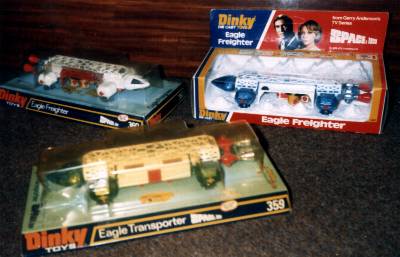
Parent company Meccano had three hugely successful toy lines: the Meccano construction system (1901), Hornby Trains (1920), and Dinky Toys, which started in the 1930s making die-cast metal cars as accessories for Hornby Trains. Dinky was one of the pioneers of the die-cast process, in which a zinc-alloy is poured into a mould. The Dinky brand was known for quality and range. Competition was other manufacturers such as Corgi, Matchbox and Mattel forced increasing accuracy, including plastic windows, working suspension and opening doors. By the start of the 1960s, children were moving on to rival toys from Lego and, for older children, radios and pop records. In 1964, suffering heavy losses, the company was sold to Lines Brothers, which sold off the Hornby railway business.
In 1965, Dinky agreed a licensing deal with Gerry Anderson, the first being Lady Penelope's FAB 1 car in 1966, quickly followed by Thunderbird 2 from Thunderbirds in 1967. In 1968, three vehicles from Captain Scarlet were even more popular. The interceptor and Shado Mobile from UFO were the top selling Dinky toys in the early 1970s. While licensing had made the toys profitable again, the Lines Brothers parent company collapsed in 1971. Airfix acquired the Meccano and Dinky companies. Most of the British toys were made by the Meccano factory in Binns Road, Liverpool, built in 1914. It finally closed in November 1979.
The original Dinky Thunderbirds, Captain Scarlet and Joe 90 models were mostly correctly coloured, but the models from UFO released in 1971 onwards were inaccurate green. From 1975, a new blue version of Thunderbird 2 was released, along with the green Eagle. Gerry Anderson remembers visiting the Binns Road factory and being told that Dinky had market research showing children preferred the bright colours (Simon Archer/Marcus Hearn, 2002). Most televisions in the UK were black and white, so many children did not know the original models were white.
International competition, particularly from cheap countries such as Hong Kong, led to the closure of Dinky in 1979. The brand was sold to Matchbox, which itself was acquired by Mattel.
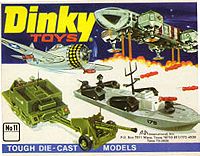
Dinky catalogue. More
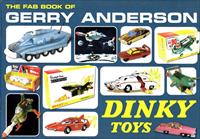
Fanderson fan club published the 64 page The FAB Book of Gerry Anderson Dinky Toys in 2010. The Dinky Eagle Transporter is covered on page 36-37 (making the grave mistake of showing an all-white Eagle and incorrectly implying it was one of "many colour variations"). The Dinky Eagle Freighter is covered on page 38-39. The Dinky catalogues are covered in appendix 1 (p48-51 covering the Eagles), and advertising in appendix 2 (p55 for the Eagle print adverts)
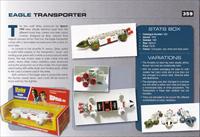
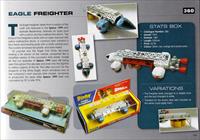
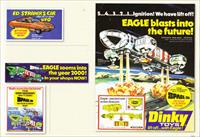
UK 1975 (Never commercially released)
32 part die-cast metal model, to be sold unassembled and unpainted. A single Eagle, with both the Transporter "life support module" and the Freighter winch pods. The box was to be a rectangular carton, featuring artwork of the Eagle with both pods, and the text "Two Toys In One!". The serial number was to be 1035, although this was used later for another kit. The design of the box appears as an illustration (incorrectly identified) in "Dinky Toys and Modelled Miniatures" by Mike and Sue Richardson, in the Hornby Companion Series (1981), and is shown here (thanks to Gerry Forrester).
Copyright Martin Willey